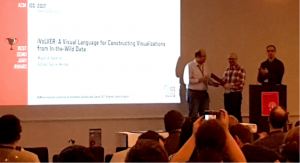Lucas’s abstract
“Indoor environment quality has a significant effect on worker productivity through a complex interplay of factors such as temperature, humidity and levels of Volatile Organic Compounds (VOCs).
In this talk I will discuss my Masters project which used off the shelf sensors and Raspberry Pis to collect environmental readings at one minute intervals throughout the Computer Science buildings. The prevalence of erroneous readings due to sensor failure and the strategy used for the identification and correction of such faults will be presented. Identifiable correlations between environmental variables and attempts to model these relationships will be discussed
Past studies identifying the ideal environmental conditions for human comfort and productivity allow for the objective assessment of indoor environmental conditions. An adaptation of Frešer’s environment rating system will be presented, showing how VOC levels can be incorporated into assessments of environment quality and how this can be communicated to building users.”
Nnamdi’s abstract
“Cloud computing is becoming an almost ubiquitous part of the computing landscape. For many companies today, moving their entire infrastructure and workloads to the cloud reduces complexity, time to deployment, and saves money. Spot Instances, a subset of Amazon’s cloud computing infrastructure (EC2), expands on this. They allow a user to bid on spare compute capacity in Amazon’s data centres at heavily discounted prices. If demand was ever to increase such that the user’s maximum bid is exceeded, their compute instance is terminated.
In this work, we conduct one of the first detailed analyses of how location affects the overall cost of deployment of a spot instance. We simultaneously examine the reliability of pricing data of a spot instance, and whether a user can be confident that their instance has a low risk of termination.
We analyse spot pricing data across all available Amazon Web Services regions for 60 days on a variety of instance types. We find that location does play a critical role in spot instance pricing and also that pricing differs depending on the granularity of the location – from a more coarse-grained AWS region to a more fine-grained Availability Zone within a region. We relate the pricing differences we find to the price’s stability, confirming whether we can be confident in the bid prices we make.
We conclude by showing that it is very possible to run workloads on Spot Instances achieving
both a very low risk of termination as well as paying very low amounts per hour.”
Event details
- When: 9th November 2017 13:00 - 14:00
- Where: Cole 1.33a
- Series: Systems Seminars Series
- Format: Seminar





